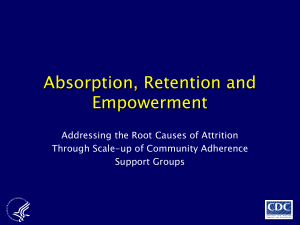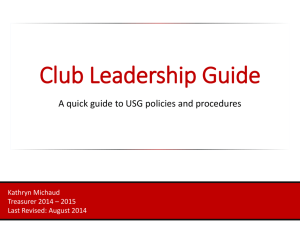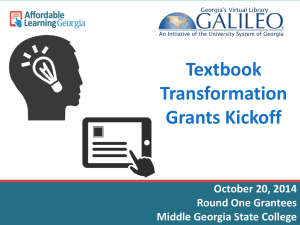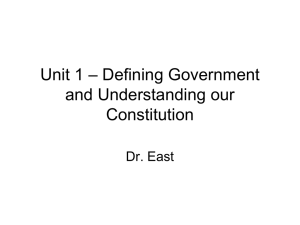United State Government
advertisement
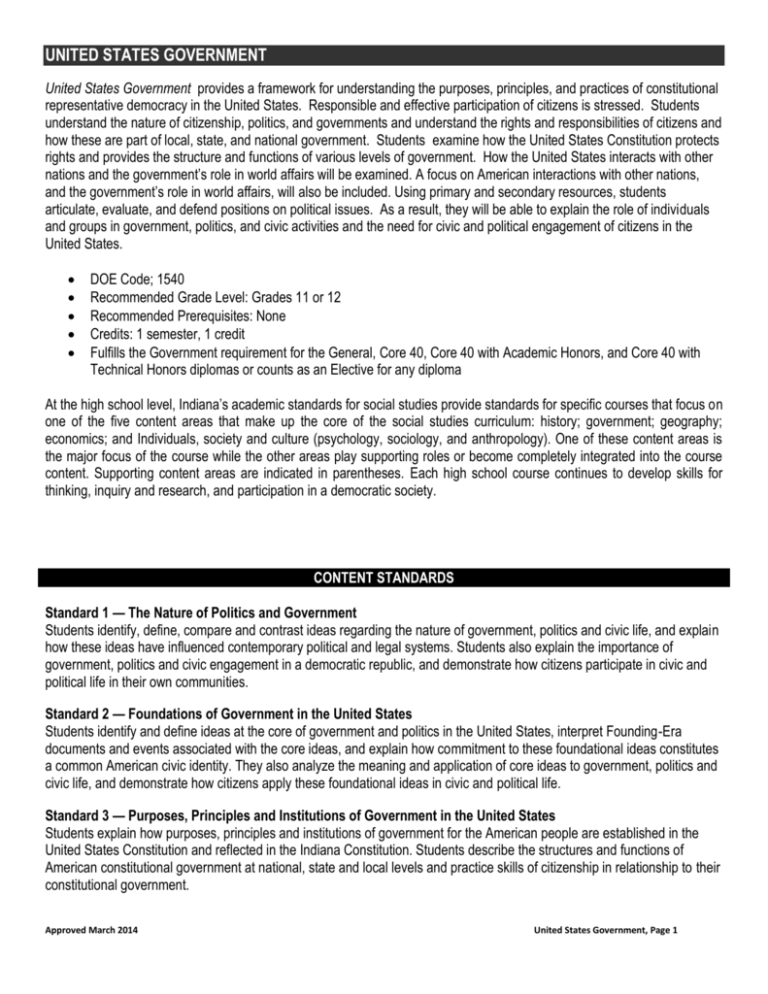
UNITED STATES GOVERNMENT United States Government provides a framework for understanding the purposes, principles, and practices of constitutional representative democracy in the United States. Responsible and effective participation of citizens is stressed. Students understand the nature of citizenship, politics, and governments and understand the rights and responsibilities of citizens and how these are part of local, state, and national government. Students examine how the United States Constitution protects rights and provides the structure and functions of various levels of government. How the United States interacts with other nations and the government’s role in world affairs will be examined. A focus on American interactions with other nations, and the government’s role in world affairs, will also be included. Using primary and secondary resources, students articulate, evaluate, and defend positions on political issues. As a result, they will be able to explain the role of individuals and groups in government, politics, and civic activities and the need for civic and political engagement of citizens in the United States. DOE Code; 1540 Recommended Grade Level: Grades 11 or 12 Recommended Prerequisites: None Credits: 1 semester, 1 credit Fulfills the Government requirement for the General, Core 40, Core 40 with Academic Honors, and Core 40 with Technical Honors diplomas or counts as an Elective for any diploma At the high school level, Indiana’s academic standards for social studies provide standards for specific courses that focus on one of the five content areas that make up the core of the social studies curriculum: history; government; geography; economics; and Individuals, society and culture (psychology, sociology, and anthropology). One of these content areas is the major focus of the course while the other areas play supporting roles or become completely integrated into the course content. Supporting content areas are indicated in parentheses. Each high school course continues to develop skills for thinking, inquiry and research, and participation in a democratic society. CONTENT STANDARDS Standard 1 — The Nature of Politics and Government Students identify, define, compare and contrast ideas regarding the nature of government, politics and civic life, and explain how these ideas have influenced contemporary political and legal systems. Students also explain the importance of government, politics and civic engagement in a democratic republic, and demonstrate how citizens participate in civic and political life in their own communities. Standard 2 — Foundations of Government in the United States Students identify and define ideas at the core of government and politics in the United States, interpret Founding-Era documents and events associated with the core ideas, and explain how commitment to these foundational ideas constitutes a common American civic identity. They also analyze the meaning and application of core ideas to government, politics and civic life, and demonstrate how citizens apply these foundational ideas in civic and political life. Standard 3 — Purposes, Principles and Institutions of Government in the United States Students explain how purposes, principles and institutions of government for the American people are established in the United States Constitution and reflected in the Indiana Constitution. Students describe the structures and functions of American constitutional government at national, state and local levels and practice skills of citizenship in relationship to their constitutional government. Approved March 2014 United States Government, Page 1 Standard 4 — The Relationship of the United States to Other Nations in World Affairs Students analyze the interactions between the United States and other nations and evaluate the role of the United States in world affairs. Standard 5 — Roles of Citizens in the United States Students explain the idea of citizenship in the United States, describe the roles of United States citizens, and identify and explain the rights and responsibilities of United States citizens. They also examine how citizens can participate responsibly and effectively in the civic and political life of the United States. Standard 1: The Nature of Politics and Government Students identify, define, compare and contrast ideas regarding the nature of government, politics and civic life, and explain how these ideas have influenced contemporary political and legal systems. Students also explain the importance of government, politics and civic engagement in a democratic republic, and demonstrate how citizens participate in civic and political life in their own communities. USG.1.1 Define civic life, political life, and private life and describe the activities of individuals in each of these spheres. (Individuals, Society and Culture) USG.1.2 Define the terms and explain the relationship between politics, government, and public policy. (Economics) USG.1.3 Interpret the purposes and functions of government found in the Preamble of the United States Constitution. (Economics) USG.1.4 Compare and contrast types of government including direct democracy, monarchy, oligarchy, and totalitarianism. (History; Individuals, Society and Culture) USG.1.5 Compare and contrast characteristics of limited and unlimited governments and provide historical and contemporary examples of each type of government. USG.1.6 Compare and contrast unitary, confederate, and federal systems of government. USG.1.7 Define and provide examples of constitutionalism, rule of law, limited government, and popular sovereignty in the United States Constitution and explain the relationship of these constitutional principles to the protection of the rights of individuals. (History; Individuals, Society and Culture) USG.1.8 Evaluate the importance of a written constitution in establishing and maintaining the principles of rule of law and limited government. USG.1.9 Evaluate how the United States Constitution establishes majority rule while protecting minority rights and balances the common good with individual liberties. (History; Individuals, Society and Culture) Approved March 2014 United States Government, Page 2 Standard 2: Foundations of Government in the United States Students identify and define ideas at the core of government and politics in the United States, interpret Founding-Era documents and events associated with the core ideas, and explain how commitment to these foundational ideas constitutes a common American civic identity. They also analyze the meaning and application of core ideas to government, politics and civic life, and demonstrate how citizens apply these foundational ideas in civic and political life. USG.2.1 Summarize the colonial, revolutionary, and Founding-Era experiences and events that led to the writing, ratification, and implementation of the United States Constitution (1787) and Bill of Rights (1791). (History; Individuals, Society and Culture) USG.2.2 Understand the concept of compromise and evaluate its application during the Constitutional Convention. USG.2.3 Analyze and interpret central ideas on government, individual rights, and the common good in founding documents of the United States. USG.2.4 Explain the history and provide examples of foundational ideas of American government embedded in the Founding-Era documents such as: natural rights philosophy, social contract, popular sovereignty, constitutionalism, representative democracy, political factions, federalism, and individual rights. USG.2.5 Identify and explain elements of the social contract and natural rights theories in United States founding-era documents. USG.2.6 Explain how a shared American civic identity is based on commitment to foundational ideas in Founding-Era documents and in core documents of subsequent periods of United States history. (History) USG.2.7 Using primary documents compare and contrast the ideas of the Federalists and the Anti-Federalists regarding the respective roles of state and national government on ratification of the United States Constitution (1787–1788). (History) USG.2.8 Explain the history and provide historical and contemporary examples of fundamental principles and values of American political and civic life, including liberty, security, the common good, justice, equality, law and order, rights of individuals, diversity, popular sovereignty, and representative democracy. (Individuals, Society and Culture) Approved March 2014 United States Government, Page 3 Standard 3: Purposes, Principles and Institutions of Government in the United States Students explain how purposes, principles and institutions of government for the American people are established in the United States Constitution and reflected in the Indiana Constitution. Students also describe the structures and functions of American constitutional government at national, state and local levels and practice skills of citizenship in relationship to their constitutional government. USG.3.1 Analyze the United States Constitution and explain characteristics of government in the United States, which define it as a federal, presidential, constitutional and representative democracy. USG.3.2 Explain the constitutional principles of federalism, separation of powers, the system of checks and balances, republican government or representative democracy, and popular sovereignty; provide examples of these principles in the governments of the United States and the state of Indiana. USG.3.3 Identify and describe provisions of the United States Constitution and the Indiana Constitution that define and distribute powers and authority of the federal or state government. USG.3.4 Explain the relationship between limited government and a market economy. (Economics) USG.3.5 Explain the section of Article IV, Section 4, of the United States Constitution which says, “The United States shall guarantee to every State in the Union a Republican form of government.” USG.3.6 Compare and contrast the enumerated, implied and denied powers in the United States Constitution and the Indiana Constitution. USG.3.7 Explain the relationships among branches of the United States government and Indiana government, which involve separation and sharing of powers as a means to limited government. USG.3.8 Describe the fiscal and monetary policies incorporated by the United States government and Indiana government and evaluate how they affect individuals, groups and businesses. (Economics) USG.3.9 Explain how a bill becomes law in the legislative process of the United States and the state of Indiana. USG.3.10 Describe the procedures for amending the United States and Indiana Constitutions and analyze why it is so difficult to amend these Constitutions. USG.3.11 Analyze the functions of the judicial branch of the United States and Indiana governments with emphasis on the principles of due process, judicial review and an independent judiciary. USG.3.12 Analyze the functions of major departments of the executive branch in the United States and in Indiana. (Individuals, Society and Culture) USG.3.13 Explain the electoral process in terms of election laws and election systems on the national, state and local level. USG.3.14 Analyze the election of Benjamin Harrison, Indiana’s only president, his approach to the presidency, his relationship to the legislative branch, and his re-election defeat, considering the effects of party politics and public opinion. Approved March 2014 United States Government, Page 4 USG.3.15 Summarize the evolution of political parties and their ideologies in the American governmental system and analyze their functions in elections and government at national, state and local levels of the federal system. (History; Individuals, Society and Culture) USG.3.16 Explain and evaluate the original purpose and function of the Electoral College and its relevance today. USG.3.17 Explain the organization of state and local governments in Indiana and analyze how they affect the lives of citizens. USG.3.18 Identify the role and development of special interest groups in politics and explain their impact on the development of state and local public policy. (Economics; History; Individuals, Society and Culture) USG.3.19 Identify the historical significance of and analyze decisions by the United States Supreme Court about the constitutional principles of separation of powers and checks and balances in such landmark cases as Marbury v. Madison (1803), Baker v. Carr (1962), United States v. Nixon (1974), Clinton v. City of New York (1998) and Bush v. Gore (2000). USG.3.20 Identify the historical significance of and analyze decisions by the United States Supreme Court about the constitutional principle of federalism in cases such as McCulloch v. Maryland (1819), Alden v. Maine (1999) and the denial of certiorari for the Terri Schiavo case (2005). (History; Individuals, Society and Culture) certiorari: a writ from a high court to a low court requesting a transcript of the proceedings of a case for review USG.3.21 Describe the influence of the media and technology on public opinion and public policy. Standard 4: The Relationship of the United States to Other Nations in World Affairs Students analyze the interactions between the United States and other nations and evaluate the role of the United States in world affairs. USG.4.1 Compare and contrast governments throughout the world with the United States government in terms of source of the government’s power. USG.4.2 Describe how different governments interact in world affairs. (Individuals, Society and Culture) USG.4.3 Analyze reasons for conflict among nations, such as competition for resources and territory, differences in ideology, and religious or ethnic conflicts. USG.4.4 Provide examples of governmental and non-governmental international organizations and explain their role in international affairs. USG.4.5 Analyze powers the United States Constitution gives to the executive, legislative and judicial branches of government in the area of foreign affairs. USG.4.6 Identify and describe strategies available to the United States government to achieve foreign policy objectives. (Economics; Geography; History; Individuals, Society and Culture) Approved March 2014 United States Government, Page 5 USG.4.7 Examine the influence individuals, businesses, labor, and other organizations, interest groups, and public opinion has on United States foreign policy. (Economics) USG.4.8 Identify and explain world issues, including political, cultural, demographic, economic and environmental challenges that affect the United States foreign policy in specific regions of the world. . USG.4.9 Discuss specific foreign policy issues that impact local community and state interests. (Economics; Individuals, Society and Culture) Standard 5: Roles of Citizens in the United States Students explain the idea of citizenship in the United States, describe the roles of United States citizens, and identify and explain the rights and responsibilities of United States citizens. They also examine how citizens can participate responsibly and effectively in the civic and political life of the United States. USG.5.1 Define the legal meaning of citizenship in the United States; identify the requirements for citizenship in the United States and residency in Indiana and understand the criteria used for attaining both. USG.5.2 Analyze the roles and responsibilities of citizens in Indiana and the United States. (Individuals, Society and Culture) USG.5.3 Discuss the individual’s legal obligation to obey the law, serve as a juror, and pay taxes. USG.5.4 Identify and describe the civil and constitutional rights found in the United States Constitution and Bill of Rights and expanded by decisions of the United States Supreme Court; analyze and evaluate landmark cases of the United States Supreme Court concerning civil rights and liberties of individuals. USG.5.5 Identify when it is constitutional for our government to limit the rights of individuals and explain the reasons why the government would want to do this. (History) USG.5.6 Explain and give examples of important citizen actions that monitor and influence local, state, and national government as individuals and members of interest groups. USG.5.7 Explain how citizens in the United States participate in public elections as voters and supporters of candidates for public office. USG.5.8 Describe opportunities available to individuals to contribute to the well-being of their communities and participate responsibly in the political process at local, state and national levels of government. USG.5.9 Use information from a variety of resources to describe and discuss current American political issues. (History, Economics, Geography) Approved March 2014 United States Government, Page 6



